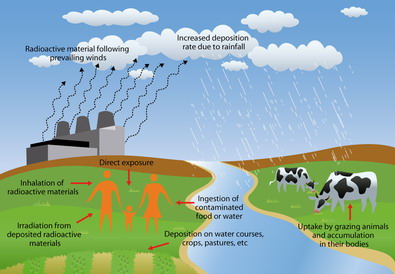Before It's News | Popular Health
Fuked Via Dust, Rain, Fog, Food & Water
Through what ENENews is calling a 'post-Fukushima Report released by the government we learn how Fukushima radiation may get into the human body. Using such avenues that we encounter nearly every day depending upon where we live, radiation can enter our bodies through rain, food, water and even dust. We also learn in this report that both plutonium and uranium can be 're-concentrated' FAR AWAY from their original source and that radioactive isotopes may likely be found across the world from Fukushima now. The video below provides proof that food coming from Japan is radioactive as our videographer clearly shows.
Post-Fukushima Report: Concern over Plutonium and Uranium being deposited and re-concentrating far away — Isotopes transfer to land via sea spray, aerosols, flooding — Human exposure by inhalation, food, contact
House of Commons Energy and Climate Change Committee (pdf), Volume II Additional written evidence, Sixth Report of Session 2012–13:
[…] scientifically attested work [...] has demonstrated the ability of several isotopes […] to re-concentrate in marine micro layers, marine sea sprays and marine aerosols and hence to transfer from the sea to the land [with] potential human exposure via inhalation, contact etc.
[…] such isotopes […] have been shown to transfer from the sea to the land (via sea spray, aerosols, flooding) and to contaminate terrestrial foodstuffs and thus enter terrestrial dietary chains.
[…] radioactivity deposited in inter tidal sedimentary environments has been shown to be susceptible to re-suspension (in drying conditions) and blowing ashore adsorbed to fine sediment particles to contaminate house dust and perhaps terrestrial foodstuffs [...]
Post-Fukushima Report: Concern over Plutonium and Uranium being deposited and re-concentrating far away — Isotopes transfer to land via sea spray, aerosols, flooding — Human exposure by inhalation, food, contact
House of Commons Energy and Climate Change Committee (pdf), Volume II Additional written evidence, Sixth Report of Session 2012–13:
[…] scientifically attested work [...] has demonstrated the ability of several isotopes […] to re-concentrate in marine micro layers, marine sea sprays and marine aerosols and hence to transfer from the sea to the land [with] potential human exposure via inhalation, contact etc.
[…] such isotopes […] have been shown to transfer from the sea to the land (via sea spray, aerosols, flooding) and to contaminate terrestrial foodstuffs and thus enter terrestrial dietary chains.
[…] radioactivity deposited in inter tidal sedimentary environments has been shown to be susceptible to re-suspension (in drying conditions) and blowing ashore adsorbed to fine sediment particles to contaminate house dust and perhaps terrestrial foodstuffs [...]


.jpeg)
7 Ways to Help Menopause Symptoms Naturally
 When a woman reaches her prime years, she may start to experience the symptoms that accompany great changes in her hormonal activity. During both perimenopause and menopause, a woman can undergo the decline of estrogen, as well as changes in progesterone and testosterone levels. This can lead to moodiness, cramping, a dampened libido, hot flashes, weight gain, and bloating, as well as copious other symptoms.
When a woman reaches her prime years, she may start to experience the symptoms that accompany great changes in her hormonal activity. During both perimenopause and menopause, a woman can undergo the decline of estrogen, as well as changes in progesterone and testosterone levels. This can lead to moodiness, cramping, a dampened libido, hot flashes, weight gain, and bloating, as well as copious other symptoms.
Fortunately, women don’t need to rely on pharmaceutical drugs to help mitigate these significant changes in her hormones. Here are 7 great natural ways to help get through menopause with ease:
1. Black Cohosh – This herb is very effective at lessening hot flashes and regulating the overall hormonal system of women. It’s been used extensively in Europe since the 1950s to help women through their entire reproductive life cycle. It can also help to initiate labor in pregnant women.
2. DHEA – Want to kick start that libido again? As we age past 30, the natural levels of DHEA in our bodies decline. Not only can it make you more amorous, but it might suppress shot flashes as well.
3. Ginseng – Is menopause getting you down? Ginseng can help to boost mood while also improving your memory and helping to elevate energy levels.
4. St. John’s Wort – Another great mood booster that eliminates sleepless nights, anxiety, moodiness and other unwanted menopause symptoms.
5. Flaxseed and Other Foods High in Lignans – Flaxseed is high in lignans, which is a phytoestrogen that also contains great antioxidant values. Lignans comprise a variety of compounds, both in food sources (secoisolariciresinol, matairesinol) and in the human body (enterodiol, enterolactone).
6. Wild Yam – This plant has been used for hundreds of years due containing a combination of estrogen and progesterone-like properties. Wild yams are also one of the foods eaten in high quantities by Okinawans, who tend to live to be more than 100 years of age.
7. Calcium – Many of the hormonal fluctuations that happen during menopause can interfere with calcium retention. This makes it an essential supplement to take, either by eating foods higher in calcium or by taking a daily tablet. Getting a little extra sun for the Vitamin D can also help your body absorb calcium for stronger bones as you age.
Additional Sources:

No comments:
Post a Comment